U.S.A. –-(AmmoLand.com)- With my spring out-of-state travel plans postponed, I decided to travel across the great state of Texas to Palo Duro Canyon, the second-largest canyon system in the United States. Even in early May, when it is seething hot elsewhere, Palo Duro is freezing by night, scorching by day, with a dehydrator’s humidity level. Plenty of views and plenty of opportunities for accidents. Now was as good of a time as ever to deploy my emergency pack containing the usual fire starting, rations, medical kit, water, and a Marlin Model 70 PSS rifle in 22 LR for shooting small game and a means of defense.
Although I didn’t get to deploy the Papoose, this little field trip was a good exercise to determine how much weight and bulk a rifle should take in a pack when your only mode of transportation is your legs. I’ve had a run on 22 take-down rifles for a couple of years now including the Henry Survival Rifle, a new and improved copy of the Armalite AR-7, as is the Ruger 10/22 takedown. Both, I have owned and shot both, but I found myself going back to the Model 70 PSS or Papoose, a rifle that is neither new nor innovative. But as all 22 caliber survival rifles are equal, some are more equal than others.

Marlin Papoose Features
Marlin is arguably the king of 22 rimfire rifles. The Papoose has been kicking around in their catalog since the mid-1980s alongside a well-known line-up of rifles like the Model 60 and the Model 795. The Papoose is essentially a 795 with a detachable sixteen-inch barrel. In the past, the model has been offered with a wooden stock and blued steel appointments, but this one is new production, sporting a polymer buttstock and a mix of matte aluminum and stainless steel.
Design-wise, the Papoose is a tried and true blowback action like the famous Model 60. It even shares some of the same parts: the same guide rod, recoil spring, steel bolt, and dual opposing extractors. It is housed in the aluminum receiver above the fire control housing that holds the hammer, magazine catch, and bolt release, all of which are sandwiched into the buttstock.
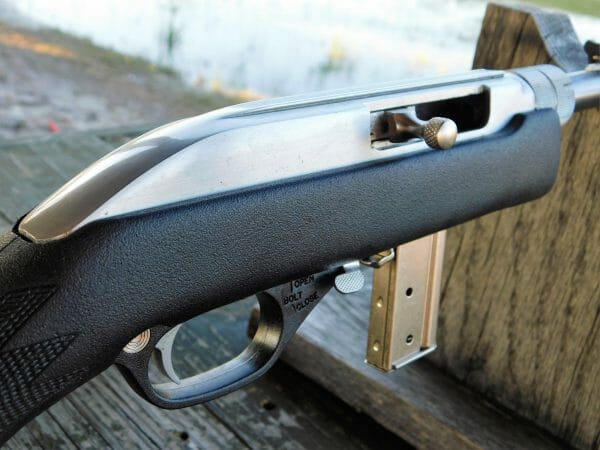
The stock itself has some checkering on the semi-pistol grip and the butt and it retains a pair of sling studs. The fore-end of the stock is recessed allowing the barrel and its captive castle nut to interface with the threaded front of the action.
The barrel comes in at sixteen inches in length and it mounts an adjustable rear notch sight and a hooded high visibility orange plastic front sight. The barrel is tapered and keyed to line up straight when inserted into the receiver. Once inserted, the castle nut is tightened over the receiver to complete the assembly of the rifle. The top of the receiver has the standard 3/8 inch groove for mounting a rimfire scope.
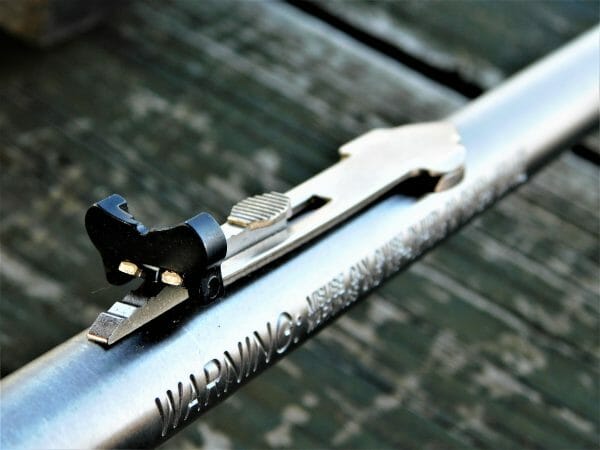
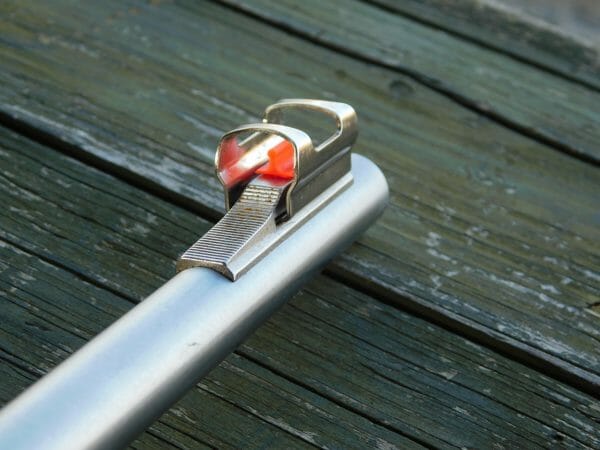
The Papoose has the typical cross-bolt safety behind the trigger guard. A push inward will block the trigger, preventing the rifle from being fired. It also has a magazine safety, preventing the gun from firing unless a magazine is inserted. It comes packed with a with a single seven-round nickel-plated magazine and a spanner wrench all wrapped in a soft, foam-padded case. The package comes in at a handy three and a quarter pounds.
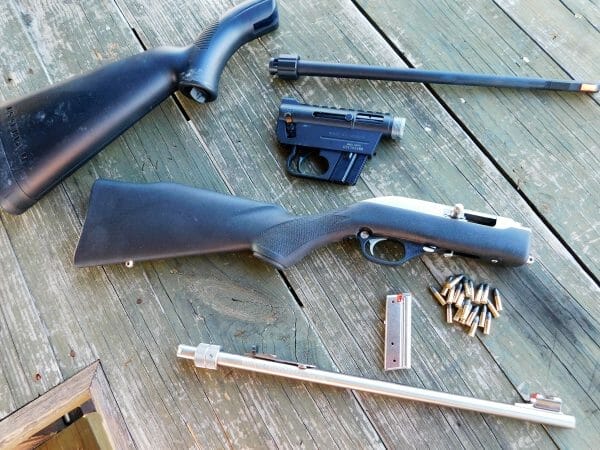
On The Range
In my two years testing the Papoose, I ran several thousand rounds of ammunition from a half-dozen manufacturers over countless range sessions. Although the rifle can be mounted and stored with an optic, I ran the Papoose with the stock iron sights. Given the intended purpose of the rifle as a gun for hunting small game, most of my targets were small six-inch circles.
Assembling the Papoose might just be the funnest part of the experience, though it isn’t so gadget-like as the Henry AR7. Still, producing and assembling a rifle that can fit in a backpack is neat. With the gun empty, the barrel is pushed into the receiver and the loose castle nut is tightened over the receiver threads. The chamber end of the barrel is chamfered in a way that it can only be inserted one way. The nut is knurled for easy tightening, but it is also keyed for a spanner wrench for extra torque.
I never used the wrench. If anything, its a tool that could be lost in the field. So all shooting was done with the gun assembled and tightened down with hand strength–which I don’t have a lot of.
Other than that, the Papoose operates like any other 22 caliber autoloading rifle. Insert the loaded magazine, pull the bolt handle back, and let fly.

On the surface, the Papoose doesn’t seem like much of a shooter. The stock is abbreviated and there is no correct way to grip the rifle with the off-hand. Throw in the fact that the sight radius is quite short, with both the front and rear sight fixed on that sixteen-inch barrel, and steady shooting doesn’t come to mind.
These objections along with its 3.25-pound weight should equal a gun that won’t hold steady or be comfortable to shoot, but appearances are deceiving. It was not difficult for me to hit a 1/2 sized steel torso target at one hundred yards offhand from the prone. I had to hold over the target to accommodate a couple of inches for the 22 LR round’s drop at that distance. The Monte Carlo at the comb on the stock, designed to place the cheek perfectly for an optic, was not an obstacle in picking up the sights. The sights and trigger pull was a great help. The sights are clean and easy to pick up on bigger targets. The trigger pull is a bit on the mushy side and there is no audible reset when letting the trigger go to ready for the next shot, but it breaks cleanly at just over five pounds.
Plinking at man-sized silhouettes is fine, but it isn’t a real test of a survival rifle that might be called upon to take pint-sized game. I spent most of my range sessions on a combination of eight-inch steel plates and six-inch paper circles out to fifty yards. The sights on most 22 rifles tend to cover up small targets, making them tricky to hit, but the irons on the Papoose are still competitive. From the bench, I can put five rounds into a hair over an inch using Federal standard velocity Target loads. For a feather-light rifle, I’ll take it.
Reliability
Reliability is never one hundred percent with any 22 rifle just because of the nature of its rimfire primed ammunition. Some ammunition is more reliable than others, but you can expect the occasional dud round. You can also expect feeding issues, especially once the rifle has been fired some. With the Papoose, and Marlin autoloaders in general, I had very good luck and I will say my example has been more reliable long-term than the examples of other take-down rifles I have examined to date. Other than dud ammunition, I counted six failures out of the four thousand rounds I put through the rifle. Five failures to fully eject after going from a clean gun to putting over three hundred rounds downrange. I also experienced a single stuck fired case that needed to be cleared with a knife.
More Upsides
The Papoose gets high marks with me as a reliable, shoot-able rifle. But there are other strengths to the rifle that set it apart. The overall package is fairly complete in a category of guns that tends to value a stripped-down minimalist design that sometimes sacrifices utility for simplicity or shedding weight. The Papoose has clean sights and an overall weather-resistant construction. The magazine release is straightforward to operate, as is the safety. The bolt hold-open feature carried over from the Model 60 has been expanded. On the last round, the gun locks open so you have a visual indicator that you are out of ammo. All that is needed to charge the rifle is inserting a fresh magazine and hitting the bolt release, which strips a round out of the magazine, loading the rifle. I can see the need to carry a survival rifle ready for instant use over a distance, so the inclusion of sling swivels is a needed and welcome touch.
The Papoose also shares some small parts with the Model 60 and 795 series of rifles, so sourcing spare parts like bolts, extractors, firing pins, magazines, charging handles, etc. is not such a chore.
Potential Downsides
Although the Marlin 70PSS punches above its weight in both performance and features, but there are a few details I am not crazy about. The first is the plastic trigger group that interfaces with the stock. The group needs to come out of the rifle along with the feed throat and the receiver. These three components are held in the stock with two hex bolts that need to come out for maintenance. Although, I have had no issues with it, the flexibility of the plastic may be a breakage concern if the group goes into the stock partway when the bolts are tongued down.
The second concern–and the only real one I could find–is the rear sight. The front sight is protected from being bumped as it is by a metal hood, but the rear sight is exposed on the barrel. The forestock is too short to give it any protection from being hit. On my first range trip, I sighted in the rifle, packed it up, and drove around with it in my trunk kit for a few days. On my next trip, the rifle shot markedly to the left. The rear sight had been hit hard enough to bump it out of alignment, somehow. I resighted the rifle, kept it in my kit, and did not see that problem reoccur. But for the sake of clarity, that might be a point of concern from a standpoint of storage.
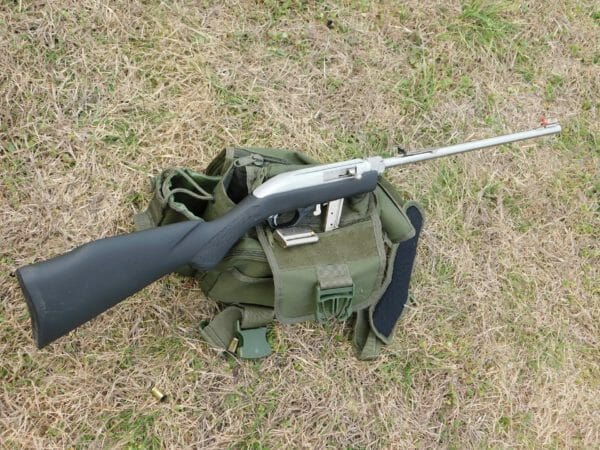
Parting Shots
Although the Marlin Model 60 and the Ruger 10/22 are considered to be the be-all and end-all of rimfire rifles with their share of lovers and haters, there is still room for other solid designs if they offer a particular advantage, whether real or perceived. The Marlin Papoose may not have the appeal of Henry’s revamped AR-7 or the modularity of the Ruger 10/22 take-down, but it is certainly a competitive option with some advantages of its own. Marlin rifles have some aftermarket support and the Papoose is no different, whether you are looking for great sights or upgraded trigger groups, or simply looking to stock common parts, the Model 60 bits will suffice. It is hard to compete with the Ruger 10/22, especially in specialized aftermarket stocks that shave the rifle’s weight down to something approaching a true backpackable survival rifle. But when it comes to a light, portable rifle that leaves all accessory options on the table without sacrificing features and weight, the Papoose just might be the one rifle to beat.
About Terril Hebert
Terril Hebert is a firearm writer native to south Louisiana. Under his motto-Guns, Never Politics-he tackles firearm and reloading topics both in print and on his Mark3smle YouTube channel, where he got his start. Terril has a soft spot for ballistics testing, pocket pistols, and French rifles. When he is not burning ammo, he is indulging his unhealthy wildlife photography obsession or working on his latest novel. Scourge of God, published in 2017. See more from Terril on youtube under Mark3smle
